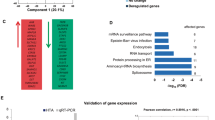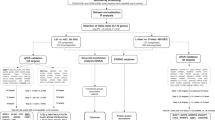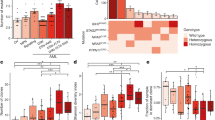Abstract
Acute promyelocytic leukaemia (APL) is a well-defined disease characterized by a typical morphology of leukaemic cells, the presence of t(15;17) translocation and the unique sensitivity to the differentiating effect of all-trans retinoic acid. Nevertheless, some aspects are variable among APL patients, with differences substantially related to morphological variants, peripheral leukocytes count, the presence of a disseminated intravascular coagulopathy, different PML/RARα isoforms (long, variable or short) and Fms-like tyrosine kinase 3 (Flt3) mutations. In order to better define this variability, we investigated the gene expression profiles of 18 APL cases revealing, besides a high uniformity in gene expression pattern, the presence of few robust differences among patients able to identify, by an unsupervised analysis, two major clusters of patients characterized by different phenotypes (hypogranular M3v vs classical M3) and by the presence or absence of Flt3 internal tandem duplications (ITDs). Further supervised analysis confirmed that Flt3 status was the APL parameter best associated with these two subgroups. We identified, between Flt3 wild-type and Flt3-ITDs subsets, 147 differentially expressed genes that were involved in the cytoskeleton organization, in the cell adhesion and migration, in the proliferation and the coagulation/inflammation pathways as well as in differentiation and myeloid granules constitution suggesting a role of Flt3 mutations in the pathogenesis and clinical manifestations of APL.
This is a preview of subscription content, access via your institution
Access options
Subscribe to this journal
Receive 12 print issues and online access
$259.00 per year
only $21.58 per issue
Buy this article
- Purchase on Springer Link
- Instant access to full article PDF
Prices may be subject to local taxes which are calculated during checkout



Similar content being viewed by others
Accession codes
References
Melnick A, Licht JD . Deconstructing a disease: RARα, its fusion partner, and their roles in the pathogenesis of acute promyelocytic leukemia. Blood 1999; 93: 3167–3215.
Bullinger L, Dohner K, Bair E, Frohling S, Schlenk RF, Tibshirani R et al. Use of gene-expression profiling to identify prognostic subclasses in adult acute myeloid leukemia. N Engl J Med 2004; 350: 1605–1616.
Schoch C, Kohlmann A, Schnittger S, Brors B, Dugas M, Mergenthaler S et al. Acute myeloid leukemias with reciprocal rearrangements can be distinguished by specific gene expression profiles. Proc Natl Acad Sci USA 2002; 99: 10008–10013.
Kohlmann A, Schoch C, Dugas M, Rauhut S, Weninger F, Schnittger S et al. Pattern robustness of diagnostic gene expression signatures in leukemia. Genes Chromosomes Cancer 2005; 42: 299–307.
Jaffe ES, Harris NL, Stein H, Vardiman JW . World Health Organization Classification of Tumors. Pathology and Genetics of Tumors of Haematopoietic Tissues. IARC Press: Lyon, France, 2001.
Brown D, Kogan S, Lagasse E, Weissman I, Alcalay M, Pelicci PG et al. A PMLRARalpha transgene initiates murine acute promyelocytic leukemia. Proc Natl Acad Sci USA 1997; 94: 2551–2556.
He LZ, Triboli C, Rivi R, Peruzzi D, Pelicci PG, Soares V et al. Acute leukemia with promyelocytic features in PML/RARalpha transgenic mice. Proc Natl Acad Sci USA 1997; 94: 5302–5307.
Grisolano JL, Wesselschmidt RL, Pelicci PG, Ley TJ . Altered myeloid development and acute leukemia in transgenic mice expressing PML-RAR alpha under control of cathepsin G regulatory sequences. Blood 1997; 89: 376–387.
Kottaridis PD, Gale RE, Frew ME, Harrison G, Langabeer SE, Belton AA et al. The presence of a FLT3 internal tandem duplication in patients with acute myeloid leukemia (AML) adds important prognostic information to cytogenetic risk group and response to the first cycle of chemotherapy: analysis of 854 patients from the United Kingdom Medical Research Council AML 10 and 12 trials. Blood 2001; 98: 1752–1759.
Thiede C, Strudel C, Mohr B, Schaich M, Schakel U, Platzbecker U et al. Analysis of FLT3-activating mutations in 979 patients with acute myelogenous leukemia: association with FAB subtypes and identification of subgroups with poor prognosis. Blood 2002; 99: 4326–4335.
Kelly LM, Kutok JL, Williams IR, Boulton CL, Amaral SM, Curley DP et al. PML/RARalpha and FLT3-ITD induce an APL-like disease in a mouse model. Proc Natl Acad Sci USA 2002; 99: 8283–8288.
Schnittger S, Schoch C, Dugas M, Kern W, Staib P, Wuchter C et al. Analysis of FLT3 length mutations in 1003 patients with acute myeloid leukemia: correlation to cytogenetics, FAB subtype, and prognosis in the AMLCG study and usefulness as a marker for the detection of minimal residual disease. Blood 2002; 100: 59–66.
Noguera NI, Breccia M, Divona M, Diverio D, Costa V, De Santis S et al. Alterations of the FLT3 gene in acute promyelocytic leukemia: association with diagnostic characteristics and analysis of clinical outcome in patients treated with the Italian AIDA protocol. Leukemia 2002; 16: 2185–2189.
Avvisati G, Lo Coco F, Diverio D, Falda M, Ferrara F, Lazzarino M et al. AIDA (all-trans retinoic acid + idarubicin) in newly diagnosed acute promyelocytic leukemia: a Gruppo Italiano Malattie Ematologiche Maligne dell'Adulto (GIMEMA) pilot study. Blood 1996; 88: 1390–1398.
Borrow J, Goddard AD, Gibbons B, Katz F, Swirsky D, Fioretos T et al. Diagnosis of acute promyelocytic leukaemia by RT-PCR: detection of PML-RARA and RARA-PML fusion transcripts. Br J Haematol 1992; 82: 529–540.
Kiyoi H, Naoe T, Yokota S, Nakano M, Minami S, Kuriyama K, et al, and the Leukemia Study Group of Ministry of Health and Welfare (Kohseisho). Internal tandem duplication of FLT3 associated with leukocytosis in acute promyelocytic leukemia. Leukemia 1997; 11: 1447–1452.
Yamamoto Y, Kiyoi H, Nakano Y, Suzuki R, Kodera Y . Activating mutation of D835 within the activation loop of FLT3 in human hematologic malignancies. Blood 2001; 97: 2434–2439.
Hughes TR, Mao M, Jones AR, Burchard J, Marton MJ, Shannon KW et al. Expression profiling using microarrays fabricated by an ink-jet oligonucleotide synthesizer. Nat Biotechnol 2001; 19: 342–347.
Eisen MB, Spellman PT, Brown PO, Botstein D . Cluster analysis and display of genome-wide expression patterns. Proc Natl Acad Sci USA 1998; 95: 14863–14868.
Efron B, Tibshirani R . Empirical Bayes methods and false discovery rates for microarrays. Genet Epidemiol 2002; 23: 70–86.
Joliffe IT . Principal Component Analysis. Springer: New York, 1986.
Shih LY, Kuo MC, Liang DC, Huang CF, Lin TL, Wu JH et al. Internal tandem duplication and Asp835 mutations of the FMS-like tyrosine kinase 3 (FLT3) gene in acute promyelocytic leukemia. Cancer 2003; 98: 1206–1216.
Au WY, Fung A, Chim CS, Lie AK, Liang R, Ma ES et al. FLT-3 aberrations in acute promyelocytic leukaemia: clinicopathological associations and prognostic impact. Br J Haematol 2004; 125: 463–469.
Simon R, Radmacher MD, Dobbin K, McShane LM . Pitfalls in the use of DNA microarray data for diagnostic and prognostic classification. J Natl Cancer Inst 2003; 95: 14–18.
Hamann J, Eichler W, Hamann D, Kerstens HM, Poddighe PJ, Hoovers JM et al. Expression cloning and chromosomal mapping of the leukocyte activation antigen CD97, a new seven-span transmembrane molecule of the secretion receptor superfamily with an unusual extracellular domain. J Immunol 1995; 155: 1942–1950.
Black RA . Tumor necrosis factor-alpha converting enzyme. Int J Biochem Cell Biol 2002; 34: 1–5.
Smyth EM, FitzGerald GA . Human prostacyclin receptor. Vitam Horm 2002; 65: 149–165.
Zipfel PF, Jokiranta TS, Hellwage J, Koistinen V, Meri S . The factor H protein family. Immunopharmacology 1999; 42: 53–60.
Napoleone E, di Santo A, Peri G, Mantovani A, de Gaetano G, Donati MB et al. The long pentraxin PTX3 up-regulates tissue factor in activated monocytes: another link between inflammation and clotting activation. J Leukoc Biol 2004; 76: 203–209.
Lorant DE, Zimmerman GA, McIntyre TM, Prescott SM . Platelet-activating factor mediates procoagulant activity on the surface of endothelial cells by promoting leukocyte adhesion. Semin Cell Biol 1995; 6: 295–303.
Hayward CP . Multimerin: a bench-to-bedside chronology of a unique platelet and endothelial cell protein – from discovery to function to abnormalities in disease. Clin Invest Med 1997; 20: 176–187.
Liu FT, Rabinovich GA . Galectins as modulators of tumour progression. Nat Rev Cancer 2005; 5: 29–41.
Almkvist J, Karlsson A . Galectins as inflammatory mediators. Glycoconj J 2004; 19: 575–581.
Sherbet GV, Lakshmi MS . S100A4 (MTS1) calcium binding protein in cancer growth, invasion and metastasis. Anticancer Res 1998; 18: 2415–2421.
Rao KN . The significance of the cholesterol biosynthetic pathway in cell growth and carcinogenesis. Anticancer Res 1995; 15: 309–314.
Cuthbert JA, Lipsky PE . Regulation of lymphocyte proliferation by cholesterol: the role of endogenous sterol metabolism and low density lipoprotein receptors. Int J Tissue React 1987; 9: 447–457.
Banker DE, Mayer SJ, Li HY, Willman CL, Appelbaum FR, Zager RA . Cholesterol synthesis and import contribute to protective cholesterol increments in acute myeloid leukemia cells. Blood 2004; 104: 1816–1824.
Liu J, Bang AG, Kintner C, Orth AP, Chanda SK, Ding S et al. Identification of the Wnt signaling activator leucine-rich repeat in Flightless interaction protein 2 by a genome-wide functional analysis. Proc Natl Acad Sci USA 2005; 102: 1927–1932.
Kawano Y, Kypta R . Secreted antagonists of the Wnt signalling pathway. J Cell Sci 2003; 116: 2627–2634.
Faurschou M, Borregaard N . Neutrophil granules and secretory vesicles in inflammation. Microbes Infect 2003; 5: 1317–1327.
Luce MJ, Burrows PD . The neuronal EGF-related genes NELL1 and NELL2 are expressed in hemopoietic cells and developmentally regulated in the B lineage. Gene 1999; 231: 121–126.
Veal E, Groisman R, Eisenstein M, Gill G . The secreted glycoprotein CREG enhances differentiation of NTERA-2 human embryonal carcinoma cells. Oncogene 2000; 19: 2120–2128.
Konopleva M, Elstner E, McQueen TJ, Tsao T, Sudarikov A, Hu W et al. Peroxisome proliferator-activated receptor gamma and retinoid × receptor ligands are potent inducers of differentiation and apoptosis in leukemias. Mol Cancer Ther 2004; 3: 1249–1262.
Levanon D, Goldstein RE, Bernstein Y, Tang H, Goldenberg D, Stifani S et al. Transcriptional repression by AML1 and LEF-1 is mediated by the TLE/Groucho corepressors. Proc Natl Acad Sci USA 1998; 95: 11590–11595.
Sanz MA, Lo Coco F, Martin G, Avvisati G, Rayon C, Barbui T et al. Definition of relapse risk and role of nonanthracycline drugs for consolidation in patients with acute promyelocytic leukemia: a joint study of thye GIMEMA and PETHEMA cooperative groups. Blood 2000; 96: 1247–1253.
Callens C, Chevret S, Cayuela JM, Cassinat B, Raffoux E, de Botton S et al. Prognostic implication of FLT3 and Ras gene mutations in patients with acute promyelocytic leukemia (APL): a retrospective study from the European APL Group. Leukemia 2005; 19: 1153–1160.
Haferlach T, Kohlmann A, Schnittger S, Dugas M, Hiddemann W, Kern W et al. AML M3 and AML M3 variant each have a distinct gene expression signature but also share patterns different from other genetically defined AML subtypes. Genes Chromosomes Cancer 2005; 43: 113–127.
Tse KF, Mukherjee G, Small D . Constitutive activation of FLT3 stimulates multiple intracellular signal transducers and results in transformation. Leukemia 2000; 14: 1766–1776.
Zheng R, Levis M, Piloto O, Brown P, Baldwin BR, Gorin NC et al. FLT3 ligand causes autocrine signaling in acute myeloid leukemia cells. Blood 2004; 103: 267–274.
Levis M, Tse KF, Smith BD, Garrett E, Small D . A FLT3 tyrosine kinase inhibitor is selectively cytotoxic to acute myeloid leukemia blasts harboring FLT3 internal tandem duplication mutations. Blood 2001; 98: 885–887.
Zheng R, Friedman AD, Small D . Targeted inhibition of FLT3 overcomes the block to myeloid differentiation in 32Dcl3 cells caused by expression of FLT3/ITD mutations. Blood 2002; 100: 4154–4161.
Zheng R, Friedman AD, Levis M, Li L, Weir EG, Small D . Internal tandem duplication mutation of FLT3 blocks myeloid differentiation through suppression of C/EBPalpha expression. Blood 2004; 103: 1883–1890.
Mizuki M, Schwable J, Steur C, Choudhary C, Agrawal S, Sargin B et al. Suppression of myeloid transcription factors and induction of STAT response genes by AML-specific Flt3 mutations. Blood 2003; 101: 3164–3173.
Kim KT, Baird K, Ahn JY, Meltzer P, Lilly M, Levis M et al. Pim-1 is up-regulated by constitutively activated FLT3 and plays a role in FLT3-mediated cell survival. Blood 2005; 105: 1759–1767.
Imai Y, Kurokawa M, Tanaka K, Friedman AD, Ogawa S, Mitani K et al. TLE, the human homolog of groucho, interacts with AML1 and acts as a repressor of AML1-induced transactivation. Biochem Biophys Res Commun 1998; 252: 582–589.
Javed A, Guo B, Hiebert S, Choi JY, Green J, Zhao SC et al. Groucho/TLE/R-esp proteins associate with the nuclear matrix and repress RUNX (CBF(alpha)/AML/PEBP2(alpha)) dependent activation of tissue-specific gene transcription. J Cell Sci 2000; 113: 2221–2231.
Michaud J, Scott HS, Escher R . AML1 interconnected pathways of leukemogenesis. Cancer Invest 2003; 21: 105–136.
Kurokawa M, Hirai H . Role of AML1/Runx1 in the pathogenesis of hematological malignancies. Cancer Sci 2003; 94: 841–846.
Planaguma J, Diaz-Fuertes M, Gil-Moreno A, Abal M, Monge M, Garcia A et al. A differential gene expression profile reveals overexpression of RUNX1/AML1 in invasive endometrioid carcinoma. Cancer Res 2004; 64: 8846–8853.
Polakis P . The oncogenic activation of beta-catenin. Curr Opin Genet Dev 1999; 9: 15–21.
Tickenbrock L, Schwable J, Wiedehage M, Steffen B, Sargin B, Choudhary C et al. Flt3 tandem duplication mutations cooperate with Wnt signaling in leukemic signal transduction. Blood 2005; 105: 3699–3706.
Acknowledgements
This work was supported by grants from Associazione Italiana per la Ricerca sul Cancro (AIRC), Milan, Italy; Associazione Italiana contro le Leucemie (AIL), Modena, Italy; Cassa di Risparmio of Modena Foundation, Modena, Italy.
Author information
Authors and Affiliations
Corresponding author
Additional information
Supplementary Information accompanies the paper on the Leukemia website (http://www.nature.com/leu).
Rights and permissions
About this article
Cite this article
Marasca, R., Maffei, R., Zucchini, P. et al. Gene expression profiling of acute promyelocytic leukaemia identifies two subtypes mainly associated with Flt3 mutational status. Leukemia 20, 103–114 (2006). https://doi.org/10.1038/sj.leu.2404000
Received:
Revised:
Accepted:
Published:
Issue Date:
DOI: https://doi.org/10.1038/sj.leu.2404000
Keywords
This article is cited by
-
Negative prognostic value of CD34 antigen also if expressed on a small population of acute promyelocitic leukemia cells
Annals of Hematology (2014)
-
Molecular characteristics and chromatin texture features in acute promyelocytic leukemia
Diagnostic Pathology (2012)
-
Gene expression analyses in acute myeloid leukaemia (AML): current status and perspectives
memo - Magazine of European Medical Oncology (2008)
-
Angiopoietin-2 expression in B-cell chronic lymphocytic leukemia: association with clinical outcome and immunoglobulin heavy-chain mutational status
Leukemia (2007)
-
Occurrence of thrombotic events in acute promyelocytic leukemia correlates with consistent immunophenotypic and molecular features
Leukemia (2007)



